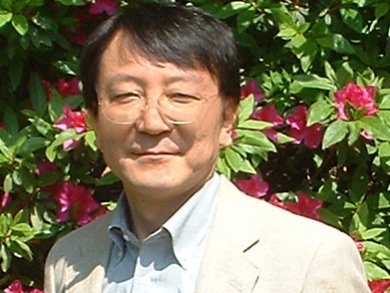Professor Masayoshi Watanabe, Yokohama National University, Japan, works on two new categories of ionic liquids, protic (PILs) and solvate ionic liquids (SILs). The definitions of both are not straightforward as in both cases the interaction between the ions determines if the materials are ionic liquids. However, both show promising applications, as Professor Watanabe explains to Dr. Vera Koester in an interview for ChemViews magazine.
Professor Watanabe, your research probes the border between ionic liquids and electrolyte solutions. Can you please tell us a bit about this?
Ionic liquids are defined as salts consisting entirely of ions, with melting points lower than 100 °C and very low vapor pressures, even in the liquid state, so you can put them inside a vacuum chamber. And also due to the very low vapor pressure ionic liquids are not flammable, even if they consist of organic compounds. As ionic liquids consist of ions, ionic conductivity is very high.
My current research focusses on the characterization of the fundamental properties of ionic liquids. We have two major interests for application as electrochemical devices, like fuel cells, and as a solvent for polymers. And we combine polymers and ionic liquids to make new materials.
There are two different classes of ionic liquids: aprotic or conventional and protic ionic liquids (PILs). Protic ionic liquids are generally prepared by a neutralization reaction of an organic base like amine and an acid. If both are strong enough, proton transfer from the acid to the base occurs. Depending on the strength of the acid and base the degree of proton transfer changes.
One of the interesting application areas of protic ionic liquids is in fuel cells. Current fuel cell technology, especially fuel cells that can be used, for example, in cars or home applications are based on ion exchange membranes. The famous one is Nafion®, a proton exchange membrane (PEM) produced by DuPont. Here, the membrane is only proton conductive when the membrane is swollen by water. Nafion® has a sulfonic acid group, so if the membrane is swollen enough by water, the sulfonic acid group dissociates and the proton conducts.
If the temperature increases, the water evaporates. As producing electricity results in heat, the fuel cell becomes hot and needs to be cooled down.
In protic ionic liquids the protonated amine functions as a proton carrier like a hydronium cation in an aqueous system conducts protons. But the thermal decomposition temperature in protic ionic liquids is much higher.
In our work, we are trying to understand how the properties of the protic ionic liquid change depending on the structure of the amines and acid and how the proton transfer is completed as a function of the property of the acid and base. And also we try to apply those protic ionic liquids to non-humidified fuel cells.
Does using ionic liquids make this technology too expensive for up scaling?
Many people think ionic liquids are expensive. This is because the purification is very difficult, as it cannot be distilled, due to the low vapor pressure. However, the preparation of the protic ionic liquids is very simple. It is just a neutralization of a base by an acid. So if we use the pure acid or base, we can prepare the pure protic ionic liquid.
You also work on lithium cation conducting ionic liquids. What do you do here?
Conventional ionic liquids consist of -onium cations, like ammonium, phosphonium, or sulfonium, and an anion. However, I want to use lithium conduction in ionic liquids.
In cell phones and computers lithium ion batteries are used. They contain aprotic organic solvents which are flammable. So misuse can result in the battery catching fire. Now, especially in Japan electric vehicles and hybrid vehicles are becoming more and more important. Especially after the big earth quake last year, discussions on how we use energy are becoming increasingly important. For example, if we introduce lots of natural energy like solar or wind energy, generation of the electricity depends on weather. So it is impossible to send this energy directly to homes or industry, which means we will need good secondary batteries.
Especially for electronic vehicles with large scale batteries compared with the conventional small sized batteries in cell phones and computers, safety becomes very important.
Lithium is a very small cation. So the coulombic interaction is very strong and generally the melting point of a lithium salt is very high.
So how can you make lithium conducting ionic liquids?
We use solvate ionic liquids which means that the lithium cation is solvated by some molecules, in this case glymes. These are oligoethers. If the lithium is completely solvated by the oligoether, a complex cation and an anion is formed, this is a kind of a new ionic liquid. But in order to build ionic liquids, the stability of the complex cation is very important.
We look at how the stability of the complex cation changes depending on the anionic structures of lithium salts.
In our research, we use a very weak Lewis basic anion, so that it poorly interacts with the lithium cation. This interaction becomes weaker than that with glymes. So I made a joke and said, the lithium cation is a beautiful lady, the anion and glyme are fighting against each other to get the lithium cation. So only when the glyme is strong enough to interact with the lithium cation and the anion weakly interacts with the lithium cation, we get a solvate ionic liquid.
How did you get interested in ionic liquids?
I am very much interested in electrolyte materials. My research after my Ph.D. degree began with polymer electrolytes. We used some polymers as a solvent typically for lithium salts and made membranes. Lithium could conduct even inside the polymers. However, the level of the conductivity was not good enough. So I started my work with the question: What happens if we combine ionic liquids and polymers? And I started studying polymer electrolytes consisting of polymers and ionic liquids. If we combine these two materials, we can get good membranes without vapor pressure and highly ion conductive.
I found that ionic liquids can be a solvent for polymers if the combination of the polymers and the ionic liquid are selected properly. In such cases we can make compatible membranes between polymers and ionic liquids.
We also found that certain combinations of polymers and ionic liquids exhibit a very interesting phase behavior. Usually there are certain combinations that are completely compatible, independent of the composition of the polymers or ionic liquids as well as the temperature. However, if we combine certain polymers and ionic liquids the homogeneous solution becomes phase separated with increasing temperature or with decreasing temperature. You may know that there are many works about hydrogels that undergo phase separation, like polyisopropylacrylamide in water.
Similar behavior is obtained by the combination of ionic liquids and polymers. We found both, high temperature soluble and low temperature insoluble, so called UCST type phase behavior as well as low temperature soluble and high temperature insoluble, LCST phase type behavior.
So by using such combinations, we can control the phase separation temperature by the molecular structure of the polymers in ionic liquids. An interesting point is that usually the solvent cannot so easily be materialized. For example, polymer gels, of course, are existent in wet conditions, but if you put the hydrogels on this desk, the solvent evaporates. If we use ionic liquids, no evaporation occurs and we can use such material even under open atmosphere or high temperatures. So now we are trying to find a new direction of such combinations by doing fundamental research.
Where do you hope this will lead sometime in the future?
Of course, I am in academia, so my standpoint is fundamental research. However, if possible, I want to realize some applications.
The most promising area right now is maybe the electrochemical application. The polymer system is still very fundamental. But anyway, I hope to produce my own material by using this new concept.
What did get you interested in sciences?
I was always very curious and interested in understanding natural phenomena. My mother, for example, told me that when I was about two to three years old I always asked her “Why?”.
When I was a kid, I very much liked insects. I looked at them, what they were doing, studied how they were behaving, sometimes I even cought some of them and tried to grow them. During that time there were no electronic games, so insects were my best toys.
What is most important for you in teaching your students?
I always say to my students: “Do good research and think for yourself”.
By careful observation of their character I try to grow the seed that each of them has inside them. It depends on each individual student how I speak to them. I think it is most important to give personal advice depending on each person’s character.
So I guess students like very much working with you.
What do you enjoy most about your job?
Research is what I enjoy most. It is kind of my hobby. Curiosity drives me, I do not get tired. And also when we can make a good paper then I am very satisfied.
Thank you very much for the interview.
 Masayoshi Watanabe studied chemistry at Waseda University, Japan, and gained his Ph.D. in engineering there in 1983. He joined the faculty at Yokohama National University, Japan, in 1992 as a lecturer and was promoted to associate, then full Professor in 1994 and 1998, respectively. From 1999–2002, he has also served as a visiting professor at the University of Tokyo, Japan.
Masayoshi Watanabe studied chemistry at Waseda University, Japan, and gained his Ph.D. in engineering there in 1983. He joined the faculty at Yokohama National University, Japan, in 1992 as a lecturer and was promoted to associate, then full Professor in 1994 and 1998, respectively. From 1999–2002, he has also served as a visiting professor at the University of Tokyo, Japan.
Professor Watanabe’s research interests focus on ionic liquids and polymer electrolytes for advanced electrochemical devices. Recently, his research has expanded to include nano-structured materials, such as intelligent gels that change their structural color in response to external stimuli. He has published more than 300 papers and 50 books in these and relating fields. (Total number of citing = ca. 10,000 ; hi-index > 54.)
Selected Publications
- How Ionic Are Room Temperature Ionic Liquids? An Indicator of the Physicochemical Properties,
Hiroyuki Tokuda, Seiji Tsuzuki, Muhammed Abu Bin Hasan Susan, Kikuko Hayamizu, Masayoshi Watanabe,
J. Phys. Chem. B 2006, 110, 19593–19600.
DOI: 10.1021/jp064159v - Thermally-Adjustable Multicolor Photochromic Hydrogel,
Kazuki Matsubara, Masayoshi Watanabe, Yukikazu Takeoka,
Angew. Chem. Int. Ed., 2007, 46, 1688–1692.
DOI: 10.1002/anie.200603554 - Non-humidified Intermediate Temperature Fuel Cells Using Protic Ionic Liquids,
Seung-Yul Lee, Atsushi Ogawa, Michihiro Kanno, Hirofumi Nakamoto, Tomohiro Yasuda, Masayoshi Watanabe
J. Am. Chem. Soc. 2010, 132, 9764–9773.
DOI: 10.1021/ja102367x - Oxidative-Stability Enhancement and Charge Transport Mechanism in Glyme-Lithium Salt Equimolar Complexes,
Kazuki Yoshida, Megumi Nakamura, Yuichi Kazue, Naoki Tachikawa, Seiji Tsuzuki, Siro Seki, Kaoru Dokko, Masayoshi Watanabe,
J. Am. Chem. Soc. 2011, 133, 13121–13129.
DOI: 10.1021/ja203983r - Polymers in Ionic Liquids: Dawn of Neoteric Solvents and Innovative Materials,
Takeshi Ueki, Masayoshi Watanabe,
Bull. Chem. Soc. Jpn. (Accounts), 2012, 85, 33–50.
DOI: 10.1246/bcsj.20110225





Masayoshi Watanabe is a well known scientist for those researcher who are pursuing research work on ionic liquid based polymer electrolyte.I am personally very very thankful to Vera Köster for whom I am able to know something about this greatest scientist Masayoshi Watanabe.This article not only describes the importance of ionic liquid in rechargeable batteries but also may attract other general people to know more about the application of ionic liquids.Thanks to Masayoshi Watanabe for his meanigful work and also to Vera Köster for bringing this conversation.